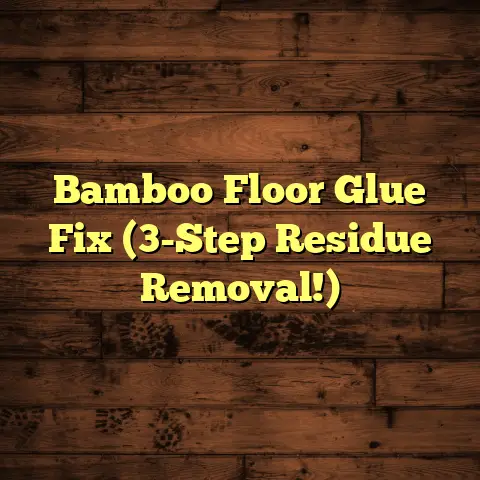Laminate Over Carpet Pad? (1 Mistake Costs $1000s!)
(1 Mistake Costs $1000s!)
Imagine this: you’re finally ready to ditch that old, stained carpet and upgrade to beautiful, modern laminate flooring. You’ve picked the perfect color, envisioned the transformation, and maybe even watched a few DIY tutorials.
You’re feeling confident, ready to tackle this project and save some money. But hold on a second! There’s one critical question you need to ask yourself: “Can I just lay the laminate right over the existing carpet pad?”
The answer, my friend, is a resounding NO! And trust me, ignoring this advice could cost you thousands of dollars in the long run. I’ve seen it happen time and time again in my years as a flooring contractor.
In this article, I’m going to break down everything you need to know about laminate flooring, why carpet pad is a definite no-no, and how to do the job right the first time. Let’s get started!
**Section 1: Understanding
Laminate Flooring**
1.1 What is Laminate Flooring?
Laminate flooring is a synthetic flooring product that’s designed to mimic the look of hardwood, tile, or stone. It’s made up of several layers:
- Wear Layer: A tough, transparent top layer that protects against scratches, stains, and fading.
- Decorative Layer: A high-resolution photographic image that gives the laminate its realistic appearance.
- Core Board: Usually made of high-density fiberboard (HDF) or medium-density fiberboard (MDF), this layer provides the flooring’s stability and durability.
- Backing Layer: A moisture-resistant layer that protects the core from water damage.
So, what makes laminate so appealing? Well, it’s durable, cost-effective, and comes in a huge variety of styles. You can get the look of expensive hardwood without breaking the bank.
1.2 The Popularity of
Laminate Flooring
Laminate flooring has exploded in popularity over the last decade, and for good reason. It fits perfectly with current home design trends that favor clean lines, modern aesthetics, and easy maintenance.
Think about it: You see laminate everywhere these days, from sleek urban apartments to cozy suburban homes. Why? Because it’s versatile, stylish, and practical.
Homeowners are increasingly choosing laminate over other flooring options like hardwood or tile for a few key reasons:
- Cost: Laminate is significantly cheaper than hardwood.
- Durability: It’s more resistant to scratches, dents, and stains than many other flooring types.
- Ease of Installation: Laminate is designed for easy DIY installation, often using a click-lock system.
- Maintenance: It’s easy to clean and requires minimal upkeep.
1.3 Basics of Laminate
Installation
Okay, so you’re sold on laminate. Now, let’s talk about the basics of installation. While it’s generally a DIY-friendly project, there are some key steps you need to follow to ensure a successful outcome.
Here’s a quick overview:
- Preparation: This is arguably the most important step. You need to make sure your subfloor is clean, level, and dry.
- Underlayment: We’ll dive deep into this later, but for now, just know that underlayment is a thin layer of material that goes between the subfloor and the laminate.
- Laying the Laminate: Using the click-lock system, you’ll connect the laminate planks together, row by row.
- Finishing Touches: Install baseboards and trim to give your floor a polished look.
To get the job done right, you’ll need a few essential tools:
- Measuring Tape: For accurate cuts.
- Pencil: For marking measurements.
- Saw: A circular saw or jigsaw works well for cutting laminate.
- Tapping Block and Hammer: To gently tap the planks together.
- Spacers: To maintain consistent expansion gaps around the perimeter of the room.
**Section 2: The Role of
Underlayment in Laminate Installation**
2.1 What is Underlayment?
Underlayment is a thin layer of material that’s installed between the subfloor (the structural floor beneath your finished floor) and the laminate flooring. Think of it as a cushion or a buffer that provides several important benefits.
There are several types of underlayment available, each with its own unique properties:
- Foam Underlayment: This is the most common type, offering good cushioning and sound insulation.
- Cork Underlayment: A natural and eco-friendly option that provides excellent sound and thermal insulation.
- Rubber Underlayment: Offers superior sound absorption and is often used in multi-story buildings.
- 2-in-1 Underlayment: Laminate flooring with attached underlayment to ease installation.
2.2 Importance of Proper
Underlayment
Why is underlayment so important? Well, it plays a crucial role in the performance and longevity of your laminate floor. Here’s how:
- Moisture Barrier: Underlayment helps protect the laminate from moisture that can seep up from the subfloor.
- Sound Insulation: It reduces noise transmission, making your floor quieter to walk on.
- Cushioning: It provides a softer feel underfoot, making your floor more comfortable.
- Leveling: It can help smooth out minor imperfections in the subfloor, creating a more even surface for the laminate.
- Support: Underlayment provides support for the laminate planks, reducing the risk of flexing or breaking under pressure.
Without proper underlayment, your laminate floor is much more likely to suffer from moisture damage, excessive noise, and premature wear and tear.
**Section 3: The Dangers of
Installing Laminate Over Carpet Pad**
3.1 Understanding Carpet Pads
Carpet pads, also known as carpet cushions, are designed to be installed underneath carpets to provide cushioning, support, and insulation. They’re typically made from materials like foam, felt, or rubber.
The primary functions of carpet pads are to:
- Increase Comfort: Provide a softer, more comfortable surface to walk on.
- Extend Carpet Life: Reduce wear and tear on the carpet fibers.
- Provide Insulation: Help insulate the floor, keeping your home warmer in the winter and cooler in the summer.
- Reduce Noise: Absorb sound, making your home quieter.
Carpet pads come in a variety of thicknesses and densities, each suited for different types of carpets and levels of traffic.
3.2 Why Carpet Pads Are Not
Suitable for Laminate Flooring
Now, here’s the million-dollar question: Why can’t you just install laminate over carpet pad? The answer boils down to structural instability.
Carpet pads are designed to be compressed under the weight of furniture and foot traffic. They have a lot of give and bounce. This is great for carpet, but it’s a disaster for laminate.
Laminate flooring needs a firm, stable, and level surface to rest on. When you install it over carpet pad, the laminate planks are essentially floating on an unstable foundation. This can lead to a whole host of problems:
- Excessive Flexing: The laminate planks will flex and bend under weight, which can damage the click-lock system and cause the planks to separate.
- Joint Separation: The constant movement can cause the joints between the planks to weaken and separate, creating unsightly gaps and potential tripping hazards.
- Squeaking: As the laminate planks rub against each other and the carpet pad, they can produce annoying squeaking noises.
- Reduced Lifespan: The instability will accelerate wear and tear on the laminate, significantly reducing its lifespan.
- Voided Warranty: Most laminate flooring manufacturers explicitly state that installing over carpet pad will void the warranty.
3.3 Real-Life Consequences of
Incorrect Installation
Don’t just take my word for it. I’ve seen the consequences of this mistake firsthand.
I remember one client, let’s call him Bob, who decided to install laminate in his living room himself. He thought he was being clever by leaving the existing carpet pad in place to save time and money.
Within a few months, Bob started noticing problems. The laminate planks were separating, the floor was squeaking, and in some areas, the planks were actually starting to buckle.
He called me in to take a look, and it was immediately clear what had happened. The carpet pad had created an unstable foundation, causing the laminate to fail prematurely.
The fix? Bob had to rip up the entire laminate floor, remove the carpet pad, prepare the subfloor properly, and install a new laminate floor with the correct underlayment.
The financial implications were significant. Bob had to pay for:
- Demolition: Removing the original laminate floor.
- Subfloor Preparation: Leveling and cleaning the subfloor.
- New Underlayment: Purchasing the correct type of underlayment.
- New Laminate Flooring: Replacing the damaged laminate.
- Professional Installation: Hiring a professional to do the job right this time.
In the end, Bob’s shortcut cost him thousands of dollars more than if he had just done it right the first time.
I’ve seen similar situations play out countless times. Homeowners try to save a few bucks by cutting corners, only to end up paying much more in the long run.
According to a study by the National Association of Home Builders (NAHB), flooring replacement is one of the most common and costly home repairs. Poor installation practices are a major contributor to these problems.
**Section 4: The Correct
Approach to Laminate Installation**
4.1 Preparing the Subfloor
As I mentioned earlier, proper subfloor preparation is absolutely critical for a successful laminate installation. Here’s a step-by-step guide:
- Remove Existing Flooring: This includes carpet, tile, vinyl, or any other existing flooring material.
- Inspect the Subfloor: Look for any signs of damage, such as cracks, holes, or water stains.
- Repair Any Damage: Fill cracks with concrete patch, replace damaged sections of plywood, and address any moisture issues.
- Clean the Subfloor: Sweep, vacuum, and mop the subfloor to remove any dirt, dust, or debris.
- Level the Subfloor: Use a self-leveling compound to smooth out any uneven areas.
- Allow to Dry: Make sure the subfloor is completely dry before proceeding with the installation.
A clean, level, and dry subfloor is essential for ensuring that your laminate floor is stable, durable, and long-lasting.
4.2 Selecting the Right
Underlayment
Choosing the right underlayment is just as important as preparing the subfloor. Here are some factors to consider:
- Subfloor Type: Concrete subfloors require underlayment with a built-in moisture barrier. Wood subfloors may not need this.
- Noise Reduction: If you live in an apartment or have kids, consider underlayment with good sound absorption properties.
- Thickness: Thicker underlayment provides more cushioning and sound insulation, but it can also raise the height of your floor.
- Cost: Underlayment prices can vary widely, so set a budget and stick to it.
Some high-quality underlayment options that I recommend include:
- QuietWalk Underlayment: This is a popular choice for its excellent sound absorption and moisture resistance.
- Eco Cork Foam Underlayment: A sustainable and eco-friendly option that provides good insulation and cushioning.
- Roberts Black Felt Underlayment: A durable and affordable option that’s suitable for a variety of subfloor types.
4.3 Installation Techniques
for Success
Once you’ve prepped the subfloor and selected the right underlayment, it’s time to start installing the laminate flooring. Here are some best practices to follow:
- Acclimate the Laminate: Allow the laminate planks to acclimate to the room’s temperature and humidity for at least 48 hours before installation.
- Install the Underlayment: Roll out the underlayment and secure it to the subfloor with tape.
- Start in a Corner: Begin laying the laminate planks in a corner of the room, working your way across the floor.
- Use Spacers: Place spacers around the perimeter of the room to maintain a consistent expansion gap.
- Tap the Planks Together: Use a tapping block and hammer to gently tap the planks together, ensuring a tight fit.
- Cut Planks as Needed: Use a saw to cut planks to fit around doorways, corners, and other obstacles.
- Install Baseboards and Trim: Once the laminate is installed, install baseboards and trim to cover the expansion gaps and give your floor a finished look.
**Section 5: Maintenance and
Care for Laminate Flooring**
5.1 How to Care for Your
Laminate Flooring
Proper maintenance and care are essential for prolonging the life of your laminate floor and keeping it looking its best. Here are some tips to follow:
- Sweep or Vacuum Regularly: Remove dirt, dust, and debris regularly to prevent scratches.
- Mop with a Damp Cloth: Use a damp cloth or mop to clean the floor, avoiding excessive water.
- Use a Laminate Floor Cleaner: Use a cleaner specifically designed for laminate floors.
- Avoid Abrasive Cleaners: Avoid using abrasive cleaners, scouring pads, or steel wool, as these can damage the wear layer.
- Protect Against Scratches: Use furniture pads under the legs of chairs and tables to prevent scratches.
- Clean Up Spills Immediately: Wipe up spills immediately to prevent staining.
Here are some common mistakes to avoid in laminate care:
- Using Too Much Water: Excessive water can seep into the seams and damage the core board.
- Using Harsh Chemicals: Harsh chemicals can damage the wear layer and dull the finish.
- Dragging Heavy Objects: Dragging heavy objects across the floor can cause scratches and dents.
5.2 Troubleshooting Common
Issues
Even with proper installation and care, you may encounter some minor issues with your laminate floor over time. Here are some common problems and how to fix them:
- Squeaking: If your floor is squeaking, try applying talcum powder to the seams.
- Gaps: If you notice gaps between the planks, you may need to replace the affected planks.
- Scratches: Minor scratches can often be repaired with a laminate repair kit.
- Buckling: If your floor is buckling, it may be due to moisture damage or improper installation.
When should you call in a professional for help? If you’re dealing with major issues like widespread buckling, severe water damage, or structural problems, it’s best to consult with a qualified flooring contractor.
**Conclusion: The Cost of
Ignoring Best Practices**
So, there you have it. Laminate flooring can be a beautiful and affordable way to transform your home, but it’s crucial to do the job right.
Remember, installing laminate over carpet pad is a recipe for disaster. It will lead to structural instability, premature wear and tear, and costly repairs down the road.
Instead, take the time to prepare the subfloor properly, select the right underlayment, and follow the best installation practices.
While it may seem like a lot of work upfront, it will save you time, money, and frustration in the long run. And most importantly, it will ensure that your laminate floor looks beautiful and lasts for years to come.
Don’t let a simple mistake cost you thousands of dollars. Invest in the right installation practices, and enjoy the beauty and durability of your laminate floor for years to come.





